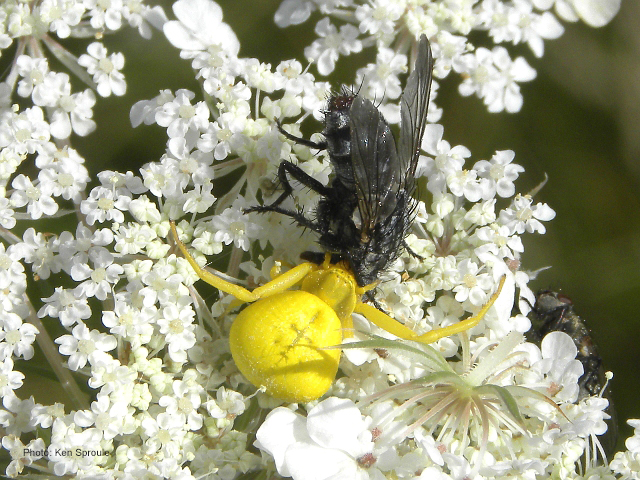
In the third post in her series on garden insects, Jean Godawa writes about the benefits of having spiders in your garden.
To me, the beauty of a garden goes beyond the sensory enjoyment it provides. The vibrant colours, varying textures and fragrant air command our attention, but it is the inner workings of the garden, the things happening regardless of our horticultural skills, that make it a special place, worthy of our awe and appreciation.
Spiders are one of those creatures with a significant role in keeping garden plants healthy and they do this with little to no help from us. By eating the bugs that destroy plants, these eight-legged animals are always on duty as pest control agents.
The female creates a complicated web that can have a diameter of more than 60 cm or 2 feet. She adds zigzag strips, called stabilimenta to the construction. Despite the name, these structures probably don't help stabilize the web. They are more likely used for attraction of prey or mates, or for warning or camouflage. It costs the spider much energy to produce these intricate patterns so they must provide some advantage. Scientists are still trying to figure it out.
Any flying insect is a potential meal for garden spiders including grasshoppers, aphids, wasps, bees and butterflies.
Some spiders prefer to capture their insect meals by ambush methods rather than expending any silk. Crab spiders (Thomisidae), use their larger front legs to easily grab their prey. Some species can change over time to match the colour of their plant surroundings.
A more active hunter is the jumping spider (Salticidae).These creatures pounce on their insect prey using their sharp vision and nimble movements.
Most spiders only live for one season. They lay eggs, usually inside silken cocoon-like structures. In some species the eggs hatch before winter but the young spiderlings remain protected in the silk until they can disperse in the spring.
Spiders feed by injecting venom into their prey to immobilize it. Digestive fluids liquefy the prey and the spider sucks up the remains. Gruesome as this sounds, most spiders are rarely dangerous to humans. They are more likely to escape your presence than to bite you.
Even an arachnophobic gardener can't deny the benefits of welcoming spiders into the garden. Tall grasses and long stemmed plants provide stable support for orb-weaving spiders to construct their webs. Other spiders prefer the dark damp conditions of thick mulch. If a garden provides these habitats, it can be sure of non-stop, natural pest control from spiders.
Bookmark this post with a Pin.





Fascinating! I try to remember that spiders are the good guys and try to stay out of their webs, which seem to be quite a feat of engineering.
ReplyDeleteWe usually only notice the spiders when their webs are covered in dew drops in the autumn, then we realise just how many there are in the garden. Spiders do a lot of good in the garden and we are always glad to see evidence of them.
ReplyDeleteThis is so interesting, Jennifer, and that ziz-zag in the web is amazing. I never knew that spiders did anything other than wait for their prey to get caught in their webs. As always, I learn something new each time I visit you here.
ReplyDeleteThank you for that, and you have a wonderful week!
Very interesting, especially in autumn we have many spiders in the garden. I like to see them but I don't know if I should like to have that black and yellow one, it looks so creepy.
ReplyDeleteThanks for great photos and info, I find garden spiders fascinating – but hate finding spiders inside the house. The ones living inside seem so big and yucky - and they are incredibly quick! I much prefer the garden spiders and I don’t mind sharing my garden with them :-)
ReplyDeleteI have never minded the spiders in the garden, though I do admit to a certain primitive panic when I walk into a web. But they're there to do their job... and some of them are so pretty! I've seen those black and yellow spiders in real life... they are quite large!
ReplyDelete